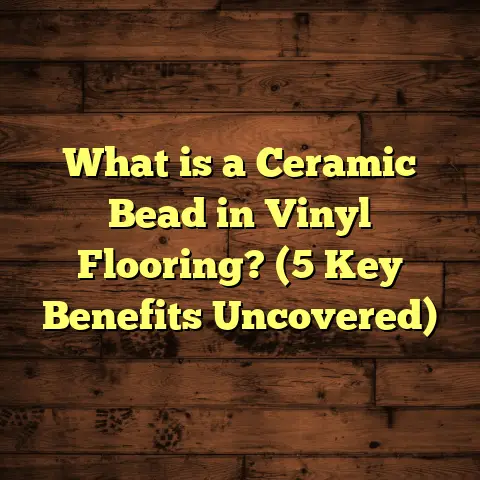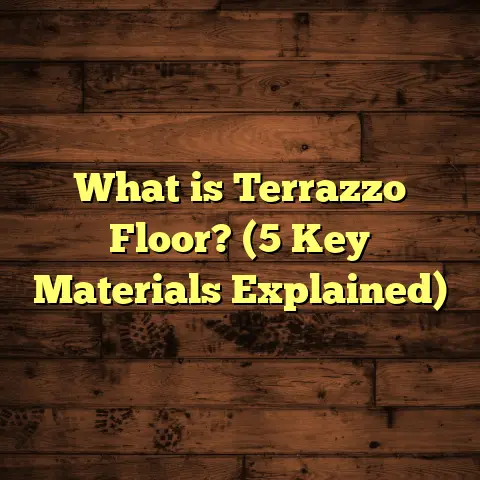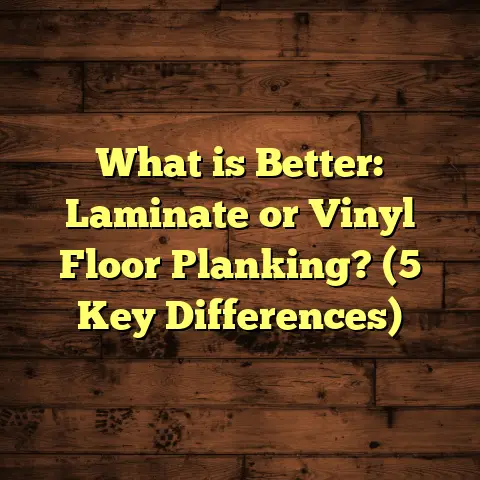What is Rodeo Flooring Made Of? (5 Essential Materials Revealed)
Spring is knocking on the door, bringing with it the energy to refresh your home. Have you ever thought about changing your floors? Maybe you’ve heard the term “Rodeo flooring” tossed around but aren’t quite sure what it means or what it’s made of. I’ve installed floors for years across all sorts of homes and businesses, and Rodeo flooring has always stood out because of its unique blend of durability and rustic charm. Let me share everything I know about Rodeo flooring—what it is, the materials that make it up, how to pick the right type, and some stories from my own projects.
What Is Rodeo Flooring?
At its core, Rodeo flooring is a style that’s rugged yet stylish. It’s designed for spaces that want a natural, worn-in look but still need floors that can take a beating. If you think about old ranch houses, barns, or even modern urban lofts that want that countryside feel, Rodeo flooring fits right in.
But what exactly makes it “Rodeo”? This term is often used to describe floors that combine rustic aesthetics with materials designed for strength and longevity. Unlike typical hardwood floors that might be all about elegance, Rodeo flooring usually involves materials that are tough, resistant to scratches and dents, and able to handle heavy foot traffic or even animals.
Over the years, I’ve found Rodeo flooring often involves five main materials. Each brings different strengths and fits different needs depending on where you’re installing it or how you want it to look.
1. Hardwood: The Classic Backbone
Hardwood has been the go-to choice for floors in America for centuries. Species like oak, hickory, pecan, and walnut are staples in Rodeo flooring because of their strength and character.
Why Hardwood?
First off, hardwood is strong. For example, oak scores around 1,200 on the Janka hardness scale—which means it resists dents better than many other woods. Hickory and pecan score even higher (hickory around 1,820), making them perfect for high-traffic areas or homes with pets.
From my experience installing hardwood floors in ranch-style homes, those natural grains and knots add personality that brand-new floors can’t replicate. Plus, hardwood ages beautifully. Over time it develops a patina that tells your home’s story.
Installation Insights
Installing hardwood requires a solid subfloor and careful acclimation of the wood before laying it down. I remember a project last spring where we waited five days for the wood to adjust to the house’s humidity before proceeding. Skipping this step can cause warping later.
Nailing or stapling hardwood requires skill to avoid damaging the wood surface. I’ve seen too many DIY jobs where improper installation caused gaps or squeaks.
Maintenance Tips
Hardwood needs some care—regular sweeping and occasional refinishing every few years keep it looking great. Avoid standing water; hardwood can warp if exposed to moisture long-term.
2. Engineered Wood: The Practical Alternative
Sometimes solid hardwood isn’t the best option—especially in basements or places with fluctuating moisture levels. That’s where engineered wood comes into play.
What Makes Engineered Wood Different?
Engineered wood consists of a thin hardwood layer on top of plywood or high-density fiberboard (HDF). This layered construction gives it more stability against changes in temperature and humidity.
For a client with a mountain cabin near a lake, engineered wood was perfect because it handled the moisture better than solid hardwood would have. Plus, it often costs less while still giving you that natural wood look.
Installation Notes
Engineered wood can be floated (not nailed down), glued, or stapled depending on the product. Floating floors are faster to install and sometimes DIY-friendly.
One tricky part is matching the thickness of the veneer to your needs. Thicker veneers allow refinishing multiple times; thinner ones are more limited.
3. Vinyl Planks with Wood Look: Durable Style
Vinyl planks have come a long way from their cheap-looking predecessors. Today’s luxury vinyl planks (LVP) can look incredibly realistic, mimicking everything from oak grain to reclaimed barnwood textures.
Why Choose Vinyl?
Vinyl is waterproof or water-resistant, making it ideal for kitchens, bathrooms, or mudrooms where spills happen often. It’s also softer underfoot than tile or concrete.
I installed vinyl plank Rodeo flooring in a busy restaurant last year—it looked like aged wood but cleaned up in minutes after spills. This saved the owner tons in maintenance costs compared to hardwood.
How Vinyl Is Made
Vinyl planks contain several layers: a backing layer for stability, a printed design layer that shows the wood grain, a wear layer protecting against scratches, and a waterproof core.
Some vinyl even has embossed textures that give a realistic feel when you run your hand over them.
Installation Tips
Vinyl plank installation is often click-lock or glue-down. It’s one of the easiest floors to install yourself if you have basic skills.
4. Reclaimed Wood: History Beneath Your Feet
Reclaimed wood flooring is exactly what it sounds like—using wood salvaged from old buildings like barns or factories. It brings character no new wood can match.
Why Reclaimed Wood?
Besides being eco-friendly by reusing materials, reclaimed wood tells stories. Each nail hole or scratch reflects decades of history.
I worked on an old ranch restoration where we sourced reclaimed pine from local barns. It was tough and full of character—perfect for Rodeo flooring’s rugged vibe.
Challenges With Reclaimed Wood
Reclaimed wood requires careful cleaning and sometimes treatment for pests or mold. It can also have uneven widths or thicknesses that need planing.
Installation takes longer because each plank must be inspected individually.
5. Concrete with Wood Overlays: A Modern Twist
Concrete floors are popular in contemporary designs but can feel cold or industrial. Adding wood overlays or stamping concrete with wood grain textures combines durability with warmth.
Why Concrete Overlays?
Concrete is incredibly durable and easy to maintain—perfect for commercial spaces or high-traffic areas.
In one project for a café renovation, we polished concrete floors stamped with wood grain patterns. It gave the space a rustic feel while standing up to daily foot traffic without damage.
Installation Details
Wood overlays can be thin layers placed over concrete or stamping techniques applied during curing. Both require skilled installers to get realistic textures.
How These Materials Stack Up: Data & Comparisons
Here’s a quick snapshot comparing these five materials based on durability, cost per square foot (material only), maintenance level, and typical lifespan:
| Material | Durability (Janka or Equivalent) | Cost per sq.ft (USD) | Maintenance | Lifespan |
|---|---|---|---|---|
| Hardwood (Oak) | 1,200 | $8 – $15 | Moderate | 30+ years |
| Engineered Wood | 700 – 1,200 | $6 – $12 | Low-Moderate | 20-30 years |
| Vinyl Planks | N/A (synthetic) | $2 – $7 | Low | 10-20 years |
| Reclaimed Wood | Varies (often high) | $10 – $20 | Moderate | 30+ years |
| Concrete Overlays | Extremely High | $8 – $18 | Low | 40+ years |
What I’ve Learned From My Clients
Over the years, I’ve noticed people love Rodeo flooring because it feels authentic without sacrificing practicality. One family told me their dog scratched up their previous laminate floors badly but barely left a mark on their new hickory Rodeo floor after six months.
Others appreciate how vinyl planks let them keep an adventurous style without worrying about spills or stains—great for busy households or rentals.
And reclaimed wood buyers often say they don’t just want a floor—they want a piece of the past beneath their feet.
Installation: What You Should Know
Installing Rodeo flooring varies depending on material:
- Hardwood typically requires professional installation.
- Engineered wood can be DIY or pro-installed.
- Vinyl planks are often DIY-friendly.
- Reclaimed wood needs experienced installers.
- Concrete overlays require specialists.
I always recommend preparing your subfloor well—clean, level surfaces help avoid issues later on like squeaks or uneven wear.
Maintenance Tips for Longevity
No matter which Rodeo material you pick, some care basics apply:
- Sweep/vacuum regularly to remove dirt.
- Use furniture pads to avoid dents.
- Clean spills quickly.
- Avoid harsh chemicals.
- For hardwood/engineered wood: periodic refinishing extends life.
- Vinyl/concrete: wash with mild soap and water regularly.
Budgeting Made Easier With Tools Like FloorTally
Budgeting flooring projects can be confusing—materials vary widely in price and installation costs fluctuate by region. I use FloorTally to get accurate estimates based on my location’s labor rates and material prices.
It lets me input room dimensions, waste factors (usually 5-10%), and specific products to see total expected cost instantly. This tool saves me hours compared to calling around vendors or making manual calculations.
Using FloorTally helped me recently quote a Rodeo floor job combining reclaimed wood with engineered backing—giving my client clear numbers upfront so they could decide without stress.
Personal Anecdotes: Challenges & Wins
One memorable project involved installing engineered Rodeo floors in a lakeside home that had humidity swings between seasons. We chose an exotic species engineered wood with extra moisture resistance and used FloorTally to budget carefully since exotic woods add cost.
The client loved how stable the floor stayed through winter freeze-thaws without gaps or buckling—a common problem we avoided by choosing engineered over solid hardwood here.
Another time, I helped convert a commercial barn into an event space using reclaimed wood flooring paired with polished concrete entryways for contrast. This mix gave the venue both durability and charm that guests rave about even years later.
Final Thoughts on Choosing Rodeo Flooring Materials
If you’re drawn to Rodeo flooring style but unsure what’s right for you:
- Think about your environment (humidity? Pets? Traffic?)
- Consider your budget realistically.
- Ask yourself how much maintenance you want.
- Picture the vibe you want—rustic warmth? Modern rustic? Practical durability?
There’s no one-size-fits-all answer here. But understanding these five essential materials gives you a solid foundation to make your decision confidently—and if you want accurate cost details, tools like FloorTally really help take the guesswork out of budgeting.
If you have questions about specific materials or want tips on installation tricks I’ve learned firsthand, just ask! Flooring is my passion, and I love sharing what I know to help you create floors that look amazing and last for decades.
Would you like me to help you explore any particular material in more detail? Or maybe share step-by-step guides based on your space? Just let me know!





